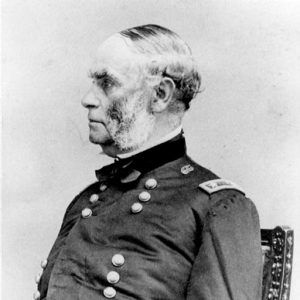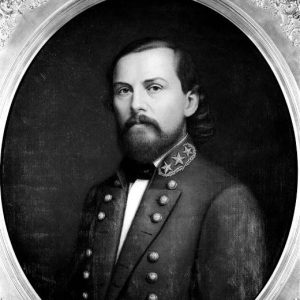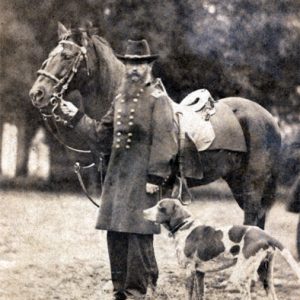calsfoundation@cals.org
Skirmish at Cache Bayou
| Location: | Monroe County, 15 miles north of Clarendon, Arkansas |
| Campaign: | Operations near Cache River (Trans-Mississippi Theater) |
| Date: | July 6, 1862 |
| Principal Commanders: | Captain Thomas J. Taylor, Brigadier General Frederick Steele, Major General Samuel R. Curtis (US); Major General Thomas C. Hindman (CS) |
| Forces Engaged: | Company “I,” Iowa Third Cavalry, Army of the Southwest (US); Trans-Mississippi Army (CS) |
| Estimated Casualties: | None (US); 7 (CS) |
| Result: | Union victory |
On July 6, 1862, dismounted members of Company “I” of the Third Iowa Cavalry turned back a Confederate attempt to halt the Federal Army of the Southwest’s movement into eastern Arkansas. A significant skirmish occurred that day at Cache Bayou approximately fifteen miles north of Clarendon (Monroe County). After encountering a barricade along the Clarendon Road, the Iowa cavalrymen pushed through the obstacle and effectively forced the Confederates to retreat across the Cache River. The Federal victory at Cache Bayou allowed the barricade to be removed successfully, thus permitting the army’s continued trudge south into Arkansas.
The Federal movement during the summer of 1862 occurred as part of the orders of Major General Henry Halleck—Federal supreme commander in the West—to cut off supplies coming from Mississippi to the Confederate army in the West, leading up to the eventual capture of Little Rock (Pulaski County), the state capital. Following the Federal victory at the Battle of Pea Ridge in March 1862, Major General Samuel R. Curtis ordered the Army of the Southwest into northeast Arkansas. Knowing the army’s presence in the region, Halleck sent Curtis orders to march from Forsyth, Missouri, to Salem (Fulton County) or down the White River to Batesville (Independence County) in order to combine forces with Brigadier General Frederick Steele. After combining their troops near Jacksonport (Jackson County) on May 4, 1862, the Federals marched south toward Clarendon.
In the advance along the Clarendon Road, members of Company “I” of the Third Iowa Cavalry came upon a Confederate barricade consisting of felled cypress trees along the path. Captain James Taylor commanded twelve of the cavalrymen to dismount and determine if enemy troops were positioned amongst the timber. Skirmishing commenced once the Federals successfully passed through the obstacle and engaged a group of eighteen Confederates in the rear of the unit. Killing seven Confederates and a number of their horses, the Federals forced the remaining eleven soldiers to retreat west across the Cache River. According to Federal reports of the Skirmish at Cache Bayou, members of Company “I” returned victorious without sustaining any casualties.
Following the success of Company “I,” the division encamped and proceeded to remove the trees from the road. Having no boundaries to block their path, the Army of the Southwest continued marching through Arkansas, eventually capturing Helena (Phillips County) that summer—which became a vital depot for the remainder of the war—and Little Rock in September 1863. In addition, the Federal trek through Arkansas also greatly impacted the local citizenry. The Army of the Southwest foraged and pillaged their way through the region during the unforgiving summer months—taking food from the Arkansans while simultaneously destroying what they did not consume. Furthermore, General Curtis went to great efforts to terminate slavery in the area. He successfully emancipated numerous slaves and seized local printing presses to create additional emancipation documents. Overall, the Federal success at the Skirmish at Cache Bayou helped to propel the Army of the Southwest’s expedition through the state and, more importantly, the ensuing Federal occupation of Arkansas.
For additional information:
Bailey, Anne J., and Daniel E. Sutherland. Civil War Arkansas: Beyond Battles and Leaders. Fayetteville: University of Arkansas Press, 2000.
Kemp, Hardy A., ed. “The War-Time Experiences, 1 December, 1861–1 January 1865, of W. B. Cox, Farrier, Company B., Sixth Missouri Volunteer Cavalry, United States Army.” White River Valley Historical Quarterly 3 (Fall 1969): 8–17.
Shea, William L. “The Confederate Defeat at Cache River.” Arkansas Historical Quarterly 52 (Summer 1993): 129–155.
Shea, William L., and Earl J. Hess. Pea Ridge: Civil War Campaign in the West. Chapel Hill: University of North Carolina Press, 1992.
Wehner, Christopher C. The 11th Wisconsin in the Civil War: A Regimental History. Jefferson, NC: McFarland & Company, 2008.
Carl C. Creason
Murray State University
 Civil War Timeline
Civil War Timeline Military
Military ACWSC Logo
ACWSC Logo  Samuel Curtis
Samuel Curtis  Thomas Hindman
Thomas Hindman  Frederick Steele
Frederick Steele 



Comments
No comments on this entry yet.